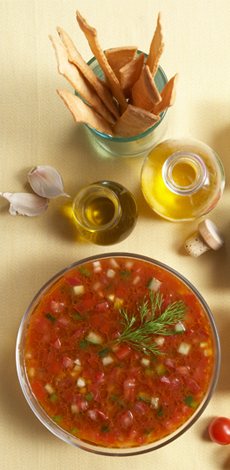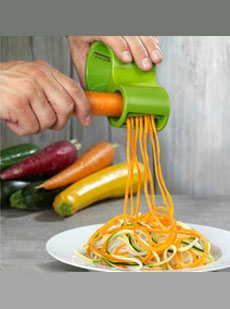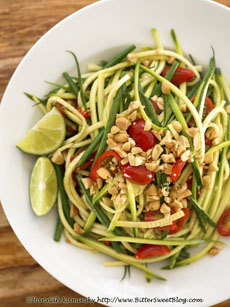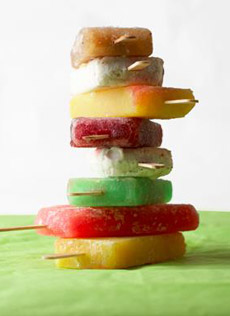
[1] A great sandwich, any time (photo © Wisconsin Dairy).

[2] Prosciutto and mozzarella are the Italian “ham and cheese” sandwich (photo © Consorzio di Prosciutto di Parma).
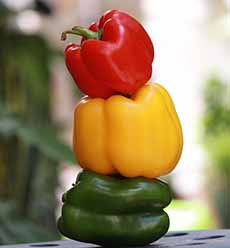
[3] Julienne three different colors of bell peppers (photo © Srinivas Bandari | Unsplash).
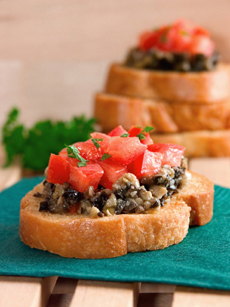
[4] Tapenade on crackers or crostini is delicious with cocktails, wine and beer (photo © Kelly Cline | iStock Photo).
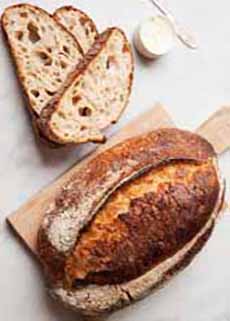
[5] We like this sandwich on country bread, but you can use whatever you like—focaccia, whole wheat, even, for fun, a bagel (photo © Good Eggs).
|
|
A delicious “surf and turf” sandwich: mozzarella, prosciutto, tapenade, and more on crunchy rustic toast. Or, call it an Italian ham and cheese sandwich with some added extras. We think of it as a summer sandwich because of the bright colors; although there’s nothing particularly summery about it and the colors will brighten your plate year-round.
You can enjoy the sandwich four ways:
With the prosciutto, mozzarella and tapenade.
With the prosciutto and mozzarella only (“ham and cheese”).
With the tapenade and mozzarella only (in which case, grill it as a “tuna melt”).
If you don’t want surf and turf, make this green olive tapenade—no fish, just an olive spread.
The second recipe, for Tuna Tapenade, is below.
RECIPE: PROSCIUTTO, MOZZARELLA & TAPENADE SANDWICH
Ingredients For 4 Sandwiches
1 cup mixed red, yellow and green peppers, julienned
1/4 cup prepared balsamic vinaigrette
1 tablespoon fresh tarragon, chopped
8 slices hearty bread (such as roasted garlic or rosemary), toasted
4 ounces prosciutto, thinly sliced
1/2 cup olive tapenade (store bought or made with this recipe)
8 ounces mozzarella cheese, thinly sliced
Preparation
1. COMBINE peppers, vinaigrette, and tarragon in a small bowl; set aside.
2. PLACE 4 slices of toasted bread on a clean surface. Top each slice with 1/4 of the prosciutto (1 ounce). Spread 2 tablespoons olive tapenade on top of the prosciutto.
3. DIVIDE mozzarella slices evenly over the tapenade. Top with the pepper mixture and cover with remaining toast slices.
WHAT IS TAPENADE
A Provençal specialty, tapenade (tah-pen-ODD) is a thick paste of olives, capers, and seasonings. You can use black or green olives, or a combination. Here’s a classic recipe.
It is typically used as an hors d’œuvre spread, on crackers or bread, or with crudités. It can be used in recipes as well; for example, to stuff fish fillets. We serve it as a condiment with grilled fish, atop or to the side.
There are many variations to the recipe. For example, you can add a can of drained tuna for tuna tapenade (the recipe is below). You can purchase ready-made tapenade in better food stores, but it’s so easy to make: Just combine the ingredients in a food processor.
RECIPE #2: TUNA TAPENADE
You can substitute green olives for the black olives (some people use a half cup of each). If you don’t like anchovies, leave them out. If you don’t like anchovies and tuna, you can substitute artichoke hearts, cooked eggplant, mushrooms, red bell peppers, or sundried tomatoes. This is an easy recipe to customize to your own preferences.
For another occasion, here’s a recipe for green olive tapenade (no fish, just olives).
Ingredients
1 cup pitted black olives*
4 tablespoons capers
1/2 lemon, zested and juiced
1 garlic clove, minced
1 tablespoon olive oil (optional)†
1 can tuna (5 to 6 ounces), drained
1 can (2 ounces) anchovies, drained
Salt and freshly ground black pepper to taste
Preparation
1. COMBINE all ingredients in a blender or food processor. Pulse until desired consistency is reached.
________________
*Canned olives are famously bland. If you like a stronger olive flavor, buy better-quality olives in the jar or from the olive bar at some supermarkets and specialty food stores—although you may need an olive pitter to remove the pits.
†We find that the oil in the drained tuna and anchovies is often sufficient. Process the mixture without the added olive oil; then decide if you need it. The added olive oil will give the tapenade a thinner consistency. If you’d like it thinner still, add more olive oil, bit by bit.
|
